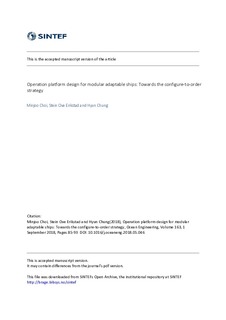| dc.contributor.author | Choi, Minjoo | |
| dc.contributor.author | Erikstad, Stein Ove | |
| dc.contributor.author | Chung, Hyun | |
| dc.date.accessioned | 2018-09-11T06:21:49Z | |
| dc.date.available | 2018-09-11T06:21:49Z | |
| dc.date.created | 2018-06-05T17:00:00Z | |
| dc.date.issued | 2018 | |
| dc.identifier.citation | Ocean Engineering. 2018, 163 85-93. | nb_NO |
| dc.identifier.issn | 0029-8018 | |
| dc.identifier.uri | http://hdl.handle.net/11250/2561854 | |
| dc.description.abstract | Modular adaptable ships have received growing attention in recent decades as a promising approach to handling uncertainty in future operating contexts. A modular adaptable ship can be used for multiple purposes by changing its module configuration. This configuration change is based on the ship's operation platform, which is used as a common basis for multiple module configurations. The design of an operation platform is a multi-objective problem in which designers have to deal with the conflicting requirements of multiple missions and carefully determine the interfaces that affect the configurability and flexibility of the modules. In this paper, we present an optimization model for the design of an operation platform. This determines the optimal platform design that best meets the desired capabilities of multiple missions while considering its expected lifecycle cost. A platform's capabilities are evaluated based on its multiple module configurations for individual missions. The evaluation of lifecycle cost uses operation scenarios due to its sensitivity. We implemented the model in a case study involving an offshore support vessel, for which an operation platform was designed to compete with inflexible multi-purpose ships. The results give insights into the platform design problem with opportunities for further improvement of the design. | nb_NO |
| dc.language.iso | eng | nb_NO |
| dc.publisher | Elsevier | nb_NO |
| dc.rights | Attribution-NonCommercial-NoDerivatives 4.0 Internasjonal | * |
| dc.rights.uri | http://creativecommons.org/licenses/by-nc-nd/4.0/deed.no | * |
| dc.title | Operation platform design for modular adaptable ships: Towards the configure-to-order strategy | nb_NO |
| dc.type | Journal article | nb_NO |
| dc.type | Peer reviewed | nb_NO |
| dc.description.version | acceptedVersion | nb_NO |
| dc.source.pagenumber | 85-93 | nb_NO |
| dc.source.volume | 163 | nb_NO |
| dc.source.journal | Ocean Engineering | nb_NO |
| dc.identifier.doi | 10.1016/j.oceaneng.2018.05.046 | |
| dc.identifier.cristin | 1589226 | |
| dc.description.localcode | © 2018. This is the authors’ accepted and refereed manuscript to the article. Locked until 5.6.2020 due to copyright restrictions. This manuscript version is made available under the CC-BY-NC-ND 4.0 license http://creativecommons.org/licenses/by-nc-nd/4.0/ | nb_NO |
| cristin.unitcode | 194,64,20,0 | |
| cristin.unitname | Institutt for marin teknikk | |
| cristin.ispublished | true | |
| cristin.fulltext | postprint | |
| cristin.qualitycode | 1 | |

